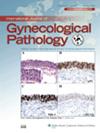Origin of Peritoneal Cancer With Features of High-grade Serous Carcinoma: A Detailed Molecular Analysis.
IF 1.6
4区 医学
Q3 OBSTETRICS & GYNECOLOGY
International Journal of Gynecological Pathology
Pub Date : 2024-09-10
DOI:10.1097/pgp.0000000000001069
引用次数: 0
Abstract
Primary peritoneal cancer has characteristics similar to high-grade serous carcinomas of ovarian and fallopian tube origin. However, the relationship between endometriosis and primary peritoneal cancer is not well understood. This study focuses on a case of peritoneal cancer in a patient who had undergone hysterectomy and bilateral salpingo-oophorectomy 5 yr before. In addition to morphology, there was a positive for TP53 in immunohistochemistry and homologous recombination deficiency test, which were similar to high-grade serous carcinomas. However, WT1 was negative in the tumor, and extensive endometriosis coexisted. To reveal the clonal relationship between tumor and endometriosis, we dissected 3 sites each from the tumor and endometriosis and performed whole-exome sequencing analysis. As a result, we found that the tumors were of identical origin. Contrarily, no shared mutations were found in the 3 endometriosis sites. Furthermore, several shared mutations were found between the tumor and 1 endometriosis tissue, showing that the tumor and 1 ectopic endometrial gland originated from the same clone. This study indicates that several peritoneal cancers may be derived from endometriosis. We should consider the possibility of more diverse origins of peritoneal cancer than we speculated before.具有高级别浆液性癌特征的腹膜癌的起源:详细的分子分析。
原发性腹膜癌的特征与卵巢和输卵管来源的高级别浆液性癌相似。然而,人们对子宫内膜异位症与原发性腹膜癌之间的关系还不甚了解。本研究的重点是一例 5 年前接受过子宫切除术和双侧输卵管切除术的腹膜癌患者。除形态学外,免疫组化和同源重组缺失试验均显示 TP53 阳性,与高级别浆液性癌相似。然而,肿瘤中的 WT1 呈阴性,且同时存在广泛的子宫内膜异位症。为了揭示肿瘤和子宫内膜异位症之间的克隆关系,我们从肿瘤和子宫内膜异位症中各分离出3个位点,并进行了全外显子组测序分析。结果我们发现,肿瘤和子宫内膜异位症的起源完全相同。相反,在子宫内膜异位症的 3 个部位没有发现共同的突变。此外,我们还在肿瘤和一个子宫内膜异位组织之间发现了几个共享突变,这表明肿瘤和一个异位子宫内膜腺体来源于同一个克隆。这项研究表明,多种腹膜癌可能源自子宫内膜异位症。我们应该考虑到腹膜癌的来源可能比我们以前推测的更加多样化。
本文章由计算机程序翻译,如有差异,请以英文原文为准。
求助全文
约1分钟内获得全文
求助全文
来源期刊
CiteScore
3.90
自引率
12.50%
发文量
154
审稿时长
6-12 weeks
期刊介绍:
International Journal of Gynecological Pathology is the official journal of the International Society of Gynecological Pathologists (ISGyP), and provides complete and timely coverage of advances in the understanding and management of gynecological disease. Emphasis is placed on investigations in the field of anatomic pathology. Articles devoted to experimental or animal pathology clearly relevant to an understanding of human disease are published, as are pathological and clinicopathological studies and individual case reports that offer new insights.

 求助内容:
求助内容: 应助结果提醒方式:
应助结果提醒方式:


